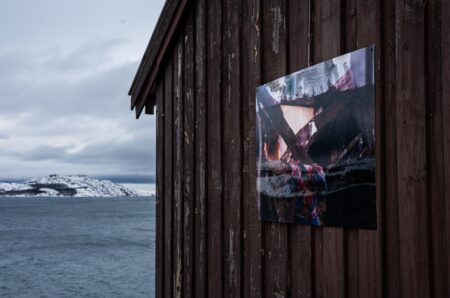
Interview with the Sámi visual artist Lada Suomenrinne, 2025.
Lada Suomenrinne is an international artist with one foot inside Sápmi and one foot outside of it. Working lens-based, and preferably on Sámi land, they constantly have to deal with the complex history of photography, which includes its abusive use against minorities. Suomenrinne found their way by making the camera transform from a rather cruel tool to a ceremonial one.
– I liked that the weather got involved without me knowing how it would turn out. Whether there would be snow or it would blow a gale in Kirkenes. That the photos got water on them is just beautiful! While looking at them, you could see both the landscape and the art. It’s like the weather became a part of my work.
Artist Lada Suomenrinne reminisces about the presentation of their works during the Barents Spektakel festival in Norway earlier this year. They were one of eight artists/art collectives contributing to the festival’s exhibition Reach Out, Stand By, Repeat. Most of the exhibition took place inside the so-called bunker house in Kirkenes—a somewhat dilapidated home built on top of a concrete bunker. The building was used as an air navigation beacon and flight monitoring station for a while after World War II. Outside this building, visitors could experience Suomenrinne’s eight photographic artworks on acrylic and aluminium, installed along the walls and concrete while the Kirkenes winter lay thick on the ground and wet snow cascaded down the photos.
The series is part of Suomenrinne’s ongoing art project, appropriately titled Emergency Weather (2024–). The artist explains that the photographs were shot before the festival’s theme, Remote Control, was announced. Even so, there is a connection to the theme in these images, consisting of portraits of Suomenrinne, various landscape motifs and a very present rock. The double exposure and experimental use of colour gives an almost spiritual aspect to the expression, where the many layers make it difficult to pinpoint what exactly it is you are looking at. It feels both removed and intimate, as if we are dealing with multiple parallel worlds.
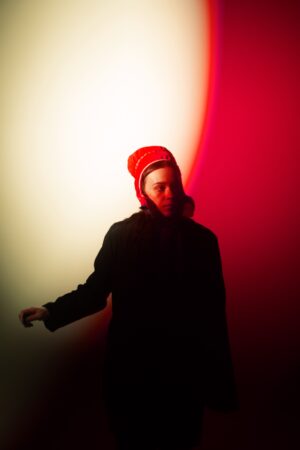
In recent years, Suomenrinne, whose works I first experienced in Kirkenes, has won awards and been featured in multiple international exhibitions, including prestigious events like Les Rencontres d’Arles in France (2023) and the Whitney Biennial (2024) in New York City. When we meet on Zoom it is mainly to talk about what it’s like to work internationally as an artist, but we can’t let their contribution to the Barents Spektakel go quite yet. After all, it tells us a great deal about Suomenrinne’s interests and the motivation for their art.
“Remote Control”
Suomenrinne has roots in Northern Russia and grew up in Njuorggán (Nuorgam), a small community in the Finnish part of Sápmi, close to the border with Norway, in Finnmark. It is in this northernmost part of Finland that they take most of their photographs. The artist explains that the title, “Emergency Weather”, is based in a desire to comment on the current and dire situation in Sápmi and the Arctic, where the loss of nature, cultural traditions and vital knowledge looms.
The artist clearly has a passion for nature conservation. This includes minimising their own footprint, as well as urging people in general to take up less space and reduce interventions in nature. So how does the artist feel about the term ‘remote control’ as the main theme for the Barents Spektakel 2025?
– I hate it.
The artist does not hesitate.
– From my perspective, as a resident of the Arctic, remote control is a geopolitical term used to describe how others view places in the high North. That’s why I don’t like it.
Growing up in Njuorggán—a place many would consider a remote community in the middle of nowhere—was, for Suomenrinne, a childhood of peace and safety. Developments in recent years have meant that peacefulness—and with it quality of life—is under threat from outside actors who believe pristine natural landscapes like this are theirs to manage and consume as they wish. This bothers the artist.
– They see it as something they can take over. Just look at the tourist industry in Inari, for example. That’s what’s happening there. They see the land’s utility, but only for themselves. Not for us, or for the land. So ‘remote control’ is actually quite a scary term. Control and remote, you know. It gives me chills, Suomenrinne says, their gaze sharp and yet also concerned.
Even though Suomenrinne was happy with their contributions to the Barents Spektakel in the end, the feeling that they did not fit inside the thematic framework remained with them for a long time. Because what did the curators really mean by ‘remote control’? And, not least, how should Suomenrinne personally relate to this horrific term? These ruminations led to the artist also producing a fabric print and an essay, presented as short text fragments at the festival.
The texts describe the tundra in Njuorggán and how the artist views the landscape as a portal to their Sámi kin, multiple generations back in time. The texts also include references to academic articles on the colonisation of certain areas, which Suomenrinne again ties to developments in Sápmi, for example in relation to mineral extraction. Eco-grief is latent in these descriptions, where poetic reflections on fishing gear, that Suomenrinne themselves do not know how to use, play an important part. The artist’s own role as a photographer is also evoked, through profound phrases like ‘Them, just staring at me through the lens. Me, just staring at the sky seeking answers.’
According to Suomenrinne, these texts are an attempt to express what remoteness really means for them personally.
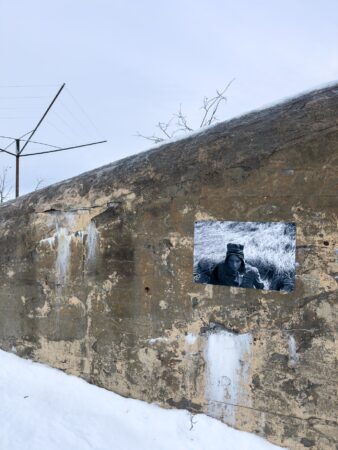
– I don’t know how to go out on the river in a boat. That knowledge is ‘remote’ from me, they explain.
But these texts also allude to the lack of educational opportunities in so-called ‘remote’ and isolated communities in the high north. People are forced to move. Suomenrinne also moved; first to Rovaniemi at 16 before their education took them to major cities around Europe.
– I was forced to move, of course. Because if you want to study, you have to leave. The idea that it’s not possible to ‘become something’ up north also creates a sense of remoteness in me, it makes me anxious. That’s why I based the essay on what it felt like for me to return to Njuorggán after having lived in Berlin and Helsinki or other places outside Sápmi.
Limited opportunities in Sápmi
This anxiety would later lead them to move back to Njuorggán, as they did when they had finished their education. They describe the move as a protest against capitalism, but also as an attempt at adaptation.
– For me, it was essential to return to Sápmi to show other people, but primarily myself, that I can live and work as an artist in a ‘remote’ community.
In an attempt to understand what Suomenrinne’s life has been like in recent years, I ask them to provide a brief summary. They describe their undergraduate studies at a private university in Berlin that left them in a lot of debt, followed by a master’s degree at Aalto University in Espoo that they thought was absolutely amazing. It was also while studying in Finland that Suomenrinne started to receive more commissions, and their career really started taking off. It’s a bit more difficult for the artist, it seems, to give a definite answer to where they lived in the years after.
– For several years, I have travelled back and forth between various places in Sápmi, Berlin and Helsinki. This past year I have spent in Njuorggán and Jåhkåmåhkke (Jokkmokk). I suppose it’s a bit of a nomadic lifestyle.
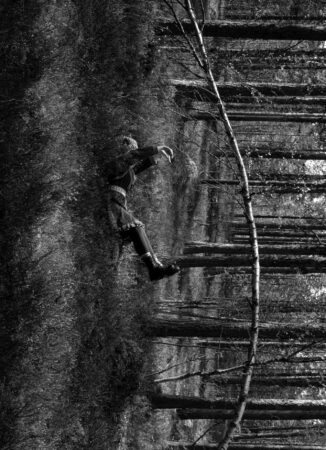
– Now, I’m about to move again. To Rovaniemi, I think. That makes it easier for me to travel both north and south.
And they have to travel south if they want to pursue a career as an artist. After all, opportunities to exhibit are all ‘out there’.
– In a utopian world, there would be more opportunities to exhibit art in Sápmi, but we don’t have the resources and facilities for that. It’s not realistic for me to have a solo exhibition in Sápmi. Because where would that be?
It’s true that an exhibition does not have to take place in a ‘conventional’ setting, like a gallery, but even if one were to set up an exhibition, say, in a forest, even that would be difficult to achieve in Sápmi, according to Suomenrinne.
– There are ideas to do things differently in Sápmi, but ideas are not enough; you also need the resources to set it up.
If you could, though, would you like to stage more exhibitions in Sápmi, or do you prefer to work internationally?
– I would love to show my art in Sápmi and have my art be part of the lives of people in Sápmi—showing diversity through art.
Some venues do exist, however. Suomenrinne highlights the Siida in Inari, a Sámi museum they believe is important because it has worked on what a Sámi museum potentially could look like and by doing that it has also recognised the kind of decolonising space a museum could be on indigenous land. The Sámi Dáiddaguovddáš art centre (SDG) in Karasjok is another important venue presenting contemporary art.
– I think the Sámi Dáiddaguovddáš’s exhibitions shows possibility, that there can be Sámi art spaces in Sápmi. On the Finnish side we have Siida, which has a gallery. But it’s still a museum and not a gallery focusing on contemporary art. I think we need to have a deeper discussion about spaces when we talk about presenting art in Sápmi. Maybe it is just a matter of having more open discussions on art, inside Sámi communities, to redefine what contemporary art actually means to us and what its purpose is, in order to create alternative spaces to show it?
Suomenrinne quickly adds that while they hope for a future with more Sámi art institutions, they don’t know what the best approach would be. Institutions are, from the beginning, a non-Sámi thing.
– I don’t really know if having a dedicated building is a very ‘Sámi’ way to do things. That may be related to my vision for the future, where we have Sámi art education programmes and courses in Sámi philosophy, and I think that should have top priority. Today there are not really words to describe the needs that we might have when we think of art educations, especially in the field of contemporary art.
Suomenrinne has always been affiliated with Western academic communities where there was a dearth of indigenous theory.
– When I wanted indigenous theory, I had to imagine possible theories myself. Think about our history and how photography was used against us. These are the things I find interesting.
Having to supplement their own reading list, however, also proved beneficial to the learning process.
– It puts me in a mode where I have to build a new academic reality for myself. I have to decolonise my own practice instead of simply studying what I’m told. It’s difficult, but also interesting. I love the work, but it gets me thinking about future generations and their opportunities. How should contemporary Sámi arts be taught? Which perspectives, and by whom, should be included?
There is no doubt that this is a passion of the artist’s, and they eagerly continue.
– Are there indigenous theories on photography? We don’t have any Sámi theories. We have no theories that could prove that photography can kill. That photography can constitute abuse. So, I don’t know. I think that is more important and more interesting than the fact that we don’t have any suitable buildings in Sápmi for exhibiting art.
What do you mean when you say photography can kill?
– It can mean so many things, but maybe the main point is that it can kill if you’re not aware of how to use a lens-based tool. ‘Photography kills’ can mean not asking permission, or to kill the emotional connection towards the living and dead beings that you’re looking at through the lens.
Suomenrinne continues to explain and points to archival photography in Sápmi where people are not named. Images where the compositions are not natural and by that also not exposing free will. Images that are not telling the truth.
– Maybe ‘photography kills’ is a radical way of describing the history of this tool that has been used against minorities. That it has posed this power relationship between individuals, or between an individual and groups.
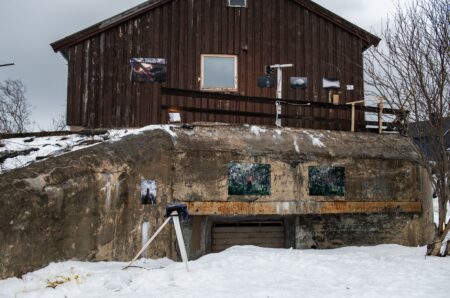
The art world kills quality
Another reason that Suomenrinne mostly exhibits their work internationally is simply the nature of how the art world functions. For Sámi artists there’s already an audience, or a platform for them to step onto internationally, Suomenrinne states.
– It is part of a trend out there—indigenous art, climate art, eco-art, the Arctic. But I think it is important to be aware that it is a trend.
Is this trend problematic, do you think?
– Yes.
Suomenrinne nods in confirmation.
– I think the increasing interest is also killing quality.
Suomenrinne has been friendly and open throughout our conversation, but I’ve also sensed a kind of wariness in their expression. To be fair, that is to be expected in an interview setting where I am communicating my interpretation of what the artist is telling me. In this case, it goes a bit deeper though. In their art, this vigilance is expressed from a deep ecological perspective, with Suomenrinne’s disquieting approach to nature and culture on the verge of disappearing. This vigilant gaze, however, also seems to have found its way into their opinion of the world of art.
Suomenrinne explains that while they are happy for all opportunities to present their art, they often feel uncertain about the intentions behind the invitations. Have they been invited as a Sámi artist simply so the organisers can tick all their boxes? The artist finds it even more problematic when curators do not have a good enough understanding of the context in which they operate.
– Not all curators have the knowledge required to curate Sámi art. If they don’t, there is a risk that the visual world and the symbolism are disregarded in their curation. And I think that kills quality—or at least the opportunity to show what Sámi contemporary art can be.
For Suomenrinne, it is essential that a curator knows how to curate, and more particularly, that curators know what they are curating. The artist argues that curatorial work can be understood as a process of world-building where curators can create new perspectives on how to look at art that represents ‘the other’.
– When I come to participate in an exhibition, I want the curator to know what they are looking for when they look at my work. And that has not always been my experience. Sometimes that’s okay, though. Not everybody will know what Sámi is. But I believe it is important to ask critical questions about what really happens to Sámi art when interest is so high and it reaches an international audience. Because Sámi art can’t be the same as Western art. We have our own way of thinking about art and what art means to us. That’s not something everybody considers, I don’t think.
– Then again, there are no public discourses on art in Sápmi, Suomenrinne adds, emphasising how the lack of curatorial terms and art discourses in Sápmi also makes it difficult for non-Sámi curators to approach this.
The camera as a ceremonial tool
According to Suomenrinne’s, their ongoing art projects, such as the already mentioned Emergency Weather, is also to be understood as an attempt to explore how the camera—a tool so strongly associated with colonialism—can be used as what Suomenrinne calls a ceremonial tool. This is a crucial part of their art practice.
– I am not a duojár, and I can’t joik, so for me, the camera is the only way I can have a ceremonial experience.
For Sámi people, joiking can be a way of deeply engaging with other species, the spirits of the dead or specific land sites. It is a very personal, and powerful way of honouring heritage, one might say, and a traditional way of singing that has existed for thousands of years. As a photographer, Suomenrinne works in a similar way. But the engagement is not confined to the moment when the shutter is pressed.
– It is about asking the place for permission to take photographs there, leaving the place as you found it and generally treating the place well, like a peer. If you light a fire, you make sure it doesn’t spread. Simple things.
Working internationally can also be problematic in terms of decolonisation, and, consequently, Suomenrinne’s method of using the camera as a ceremonial tool.
– Using the camera in a decolonising way is also about knowing when not to photograph. And perhaps also whether it’s okay to photograph in unfamiliar areas where you don’t know the language or the history. It can be complicated.
Some time ago, Suomenrinne was invited to participate in an art project that would have involved taking photographs in the Amazon jungle. Ultimately, the project never happened, but early in the planning stage, Suomenrinne expressed doubts about being able to take photographs or film at the location.
– I don’t feel like I have the right to do that there. You have to also keep in mind that if I travel to the Amazon, I will go there as a person with a different skin colour, a colour of privilege. I am not speaking the language of the land, and I don’t have the knowledge of the existing cultures, living and dead beings. And I would be bringing my camera as a tool. That would put me in a position where I have to consider my privileges before I take a photo.
Despite everything that is problematic with the international art world, you seem to still want to be a part of it?
– Sure. But I think that is the only way to survive as an artist. I completely understand anyone who would not want to be part of it. It can be difficult at times. But one thing that has been really important for me is that the big international exhibitions also have given me opportunities to get to know other Indigenous artists. And that’s so important!
With a self-deprecating chuckle, Suomenrinne goes on to describe their big ambitions, which are part of their drive to pursue more international work.
– I have this wild goal of becoming as big internationally as, say, Ai WeiWei. I would love to see myself or another Sámi artist reach that level of recognition. Imagine having the resources to be able to make productions that big—I think I could have created some fantastic visual worlds, the likes of which we have never seen before!
Whether or not this goal is realistic does not matter to Suomenrinne.
– Even if it doesn’t happen, I think it’s good to manifest the idea that it could happen. I don’t think I’d be able to survive as an artist without that kind of drive. Perhaps the reality is that ten years from now, I’ll be working in a supermarket or a kindergarten, living in Sápmi with a couple of dogs. Without the resources Ai WeiWei has.
Surely, living in Sápmi would not be a disappointment in any way, for Suomenrinne. After all, the local nature—the artist’s own backyard in Njuorggán—is the setting they prefer to, and perhaps also should, be working from.
– I am happy working in Sápmi and telling people about my backyard. I believe that place is big enough for me to explore as an artist. There is still so much out there, and perhaps that’s all I need. It’s also my privilege. The fact that I have my own backyard and my home to work from. Considering the situation in the world today, like with the ongoing genocide happening in Gaza, that’s something I must also value. And I would much rather do that than travel far away to create exotic photos of something I don’t understand. I’m not judging anybody, but for me, that is the essence of being a Sámi photographer.
This text is a collaboration with the Finnish-Norwegian Cultural Institute (NO: Finsk-norsk kulturinstitutt) as part of the pARTir initiative funded by the European Union – NextGenerationEU.


